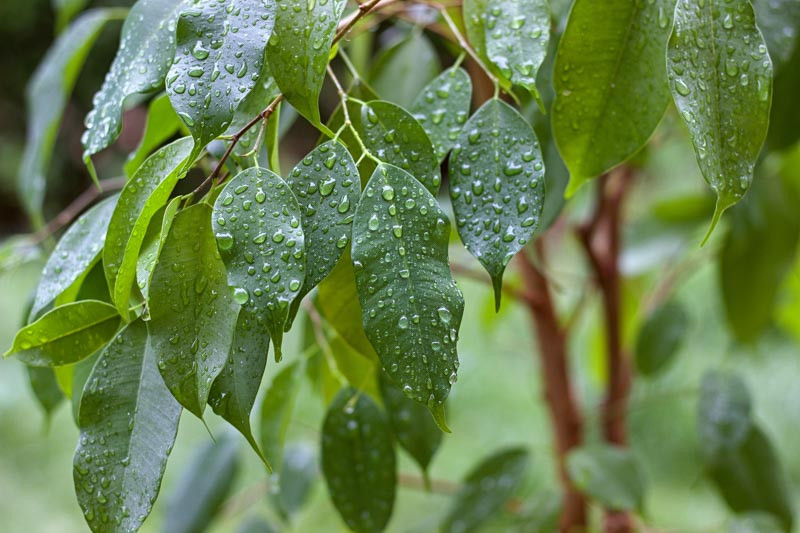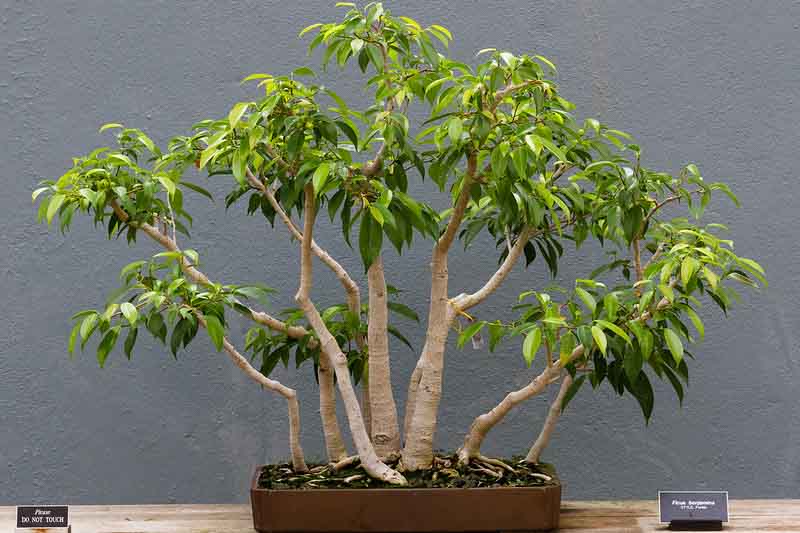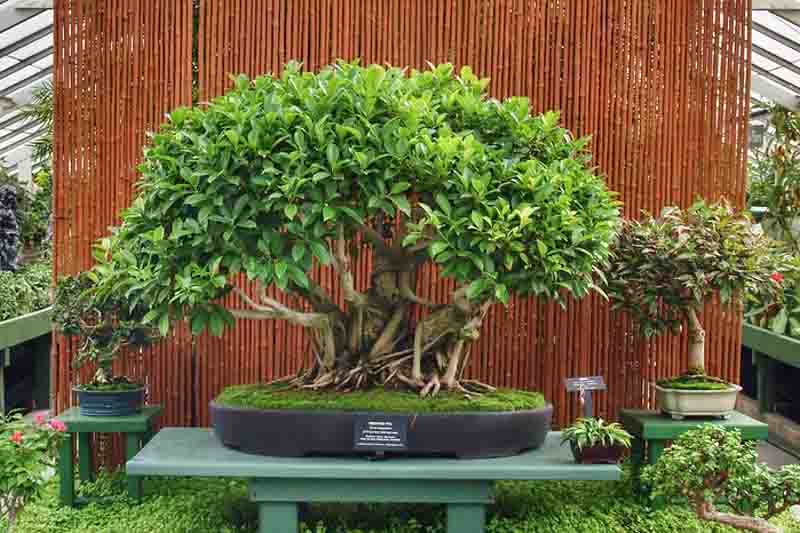Weeping Fig, Benjamin Tree, Java Fig, Java Tree, Small-Leaved Rubber Plant, Tropic Laurel, Waringin, Ficus nitida
Ficus benjamina, commonly known as the Weeping Fig, is a popular houseplant known for its graceful, drooping branches and glossy green leaves.
Native: It is native to Southeast Asia and Australia, thriving in tropical and subtropical climates. It belongs to the mulberry and fig family Moraceae.
Plant Type and Habit: This fig species is an evergreen shrub or tree adorned with a dense, rounded canopy and gracefully drooping branches. Weeping Fig is widely grown in the tropics, becoming huge and massive. Aerial roots descend from the branches, touch the ground, and take root, eventually forming numerous sturdy trunks that can clog a landscape. In warm climates devoid of high humidity, the tree does not develop aerial roots but grows to a respectable height. Grown indoors, Weeping Fig grows much smaller and makes an attractive houseplant.
Size: In its natural habitat, it can grow up to 40-50 feet tall (12-15 meters) and 25-30 feet wide (7.5-9 meters). Indoors, it is typically much smaller, usually around 3 to 6 feet (90-180 cm).
Flowers: Ficus benjamina produces small, inconspicuous flowers that are rarely seen in indoor environments. Tiny, deep red figs, turning purplish black, appear on outdoor plants but rarely appear on indoor plants.
Foliage: The plant is highly valued for its lush, verdant foliage, featuring slender, pointed ovate leaves about 5 inches (12 cm) long. These leaves boast a rich, glossy finish, elegantly arching downwards to create a graceful, luxuriant appearance. This distinctive drooping characteristic contributes to the plant’s overall aesthetic appeal, enhancing its charm as a decorative indoor element.
Bark: The bark is smooth and light gray, becoming more textured with age.
Uses: Widely used as an indoor houseplant. Suitable for bonsai. Commonly used in landscaping in suitable climates.
Award: Recipient of the prestigious Award of Garden Merit of the Royal Horticultural Society.
Hardiness: It is hardy in USDA zones 10-12. Not tolerant of cold temperatures.
Toxicity: Ficus contain a sap that is toxic to pets and humans when ingested. The sap irritates the mouth and stomach. Contact with its sap can also lead to skin irritation for some individuals.
Drought: Moderately drought-tolerant but prefers consistent moisture.
Invasiveness: It can become invasive in tropical climates if not controlled.
Benefits: Like many houseplants, it’s an excellent air purifier, removing toxins such as formaldehyde from indoor environments.

The Weeping Fig is notoriously finicky about water, light, and transplanting.
Lighting: While this fig tree can tolerate various light levels, it likes consistency and looks its best when grown in bright, indirect light. Direct sun can scorch its leaves, while too little light can cause leaf drop. A spot near an east or west-facing window is ideal. If the plant is moved, expect it to drop leaves and produce new ones accustomed to the new light conditions.
Watering: Water when the top inch of the soil feels dry. Be cautious not to overwater, as this can lead to root rot. The watering frequency will depend on the humidity and temperature of your home.
Temperature and Humidity: Keep your Ficus benjamina in a warm environment, ideally between 60-75°F (15-24°C). Avoid exposure to drafts and sudden temperature fluctuations. This plant thrives in a humid environment. If indoor air is dry, especially in winter, consider using a humidifier or placing the plant’s pot on a tray of watered pebbles.
Soil and Repotting: Use a well-draining potting mix. A mixture designed for houseplants or one that includes perlite and peat moss works well.
Fertilizing: Fertilize monthly during the growing season (spring and summer) with a balanced, water-soluble fertilizer. Reduce feeding in the fall and winter months.
Pruning and Cleaning: Prune as needed to shape the plant or to remove any dead or damaged foliage. Regular pruning encourages fuller growth.
Propagation: Propagate by seed, leaf-bud or semi-hardwood cuttings.

Caring for Ficus benjamina, also known as the Weeping Fig, outdoors requires attention to its specific needs, particularly in terms of climate, light, and watering:
Climate Suitability: Ficus benjamina thrives in warm, humid climates, typically suitable for USDA hardiness zones 10-12. It should be protected from frost in regions with cooler temperatures and may need to be brought indoors during colder months.
Sunlight: This tree prefers bright, indirect sunlight when grown outdoors. It can tolerate some direct sunlight, but too much can cause leaf scorch. In very hot climates, some afternoon shade is beneficial. Site in a location protected from wind and afternoon sun.
Soil: Plant in rich, well-draining soil. Ficus benjamina is adaptable to various soil types but prefers a slightly acidic to neutral pH.
Watering: Regular watering is crucial, especially during dry periods. Allow the soil to dry out slightly between waterings. Avoid overwatering, as Ficus benjamina dislikes sitting in waterlogged soil.
Fertilizing: Fertilize with a balanced fertilizer during the growing season to promote healthy growth. Reduce feeding in the fall and winter.
Pruning: Prune to shape the tree and control its size. Regular pruning also helps to encourage denser foliage. Remove any dead or diseased branches to maintain the health of the tree.
Mulching: Apply a layer of mulch around the base to retain soil moisture and regulate temperature.
Winter Care: Provide extra mulch for root protection in areas with mild winters. In colder zones, the Weeping Fig should be grown in a pot and brought indoors for the winter.

The Weeping Fig, like any plant, can be susceptible to various pests, diseases, and other common problems.
Aphids: They are small, sap-sucking insects, often green or black, which cluster on new growth and undersides of leaves. They excrete sticky honeydew, leading to sooty mold. Treatment includes washing them off with water or using insecticidal soap.
Spider mites: These tiny pests can cause yellowing or speckling on leaves. You may also see fine webs. Increase humidity around the plant and wipe the leaves with a damp cloth. If infestation persists, use insecticidal soap or neem oil.
Mealybugs: These small, white, cottony pests suck sap from the leaves, weakening the plant. They can be removed with a cotton swab dipped in rubbing alcohol or treated with insecticidal soap.
Scale insects: These look like small, brown, bumpy spots on stems and leaves. They can be scraped off gently or treated with neem oil or insecticidal soap.
Root rot: Overwatering can lead to root rot, a serious condition that can kill the plant. Signs include yellowing leaves, wilting, and a musty smell from the soil. Prevent it by ensuring proper drainage and allowing the soil to dry between waterings.
Leaf spot: This can be caused by either fungal or bacterial infections, leading to brown or black spots on the leaves. Improve air circulation, avoid wetting the leaves, and remove affected leaves. Fungicide or bactericide may be needed in severe cases.
Stunted Growth or Sparse Leaves: Often due to insufficient light or improper fertilization.
Yellowing Leaves: Overwatering, under-watering, or poor drainage can lead to yellowing leaves.
Leaf Drop: Sudden changes in temperature, light, or water can cause Ficus benjamina to drop its leaves.
Brown Leaf Tips: Usually a sign of dry air or irregular watering.

Yes, Ficus benjamina is a good indoor plant for several reasons:
Ficus benjamina can live for many years under the right conditions. Indoors, with proper care, it can thrive for 20 years or more.
Ficus benjamina is considered to have a moderate difficulty level in terms of care. It’s not particularly challenging, but it does require attention to its specific needs, like light, water, and temperature.
Yes, weeping figs are good indoor plants for similar reasons as Ficus benjamina (they are the same plant). They are visually appealing and effective at improving indoor air quality.
Ficus benjamina prefers bright, indirect sunlight. Direct sun can burn its leaves, while too much shade can lead to sparse foliage and leaf drop. A balance is key, with ideally a few hours of indirect sunlight each day.
| Hardiness |
10 - 12 |
|---|---|
| Heat Zones |
10 - 12 |
| Climate Zones | 13, 23, 24, H1, H2 |
| Plant Type | Houseplants, Trees |
| Plant Family | Moraceae |
| Genus | Ficus |
| Common names | Weeping Fig |
| Exposure | Full Sun, Partial Sun |
| Season of Interest |
Spring (Early, Mid, Late) Summer (Early, Mid, Late) Fall Winter |
| Height |
40' - 50' (12.2m - 15.2m) |
| Spread |
25' - 30' (7.6m - 9.1m) |
| Maintenance | Low |
| Water Needs | Average |
| Soil Type | Chalk, Clay, Loam, Sand |
| Soil pH | Acid, Alkaline, Neutral |
| Soil Drainage | Moist but Well-Drained |
| Characteristics | Plant of Merit, Showy, Evergreen, Fruit & Berries |
| Native Plants | Australia |
| Tolerance | Drought |
| Garden Uses | Patio And Containers |
| Garden Styles | Mediterranean Garden |
| Hardiness |
10 - 12 |
|---|---|
| Heat Zones |
10 - 12 |
| Climate Zones | 13, 23, 24, H1, H2 |
| Plant Type | Houseplants, Trees |
| Plant Family | Moraceae |
| Genus | Ficus |
| Common names | Weeping Fig |
| Exposure | Full Sun, Partial Sun |
| Season of Interest |
Spring (Early, Mid, Late) Summer (Early, Mid, Late) Fall Winter |
| Height |
40' - 50' (12.2m - 15.2m) |
| Spread |
25' - 30' (7.6m - 9.1m) |
| Maintenance | Low |
| Water Needs | Average |
| Soil Type | Chalk, Clay, Loam, Sand |
| Soil pH | Acid, Alkaline, Neutral |
| Soil Drainage | Moist but Well-Drained |
| Characteristics | Plant of Merit, Showy, Evergreen, Fruit & Berries |
| Native Plants | Australia |
| Tolerance | Drought |
| Garden Uses | Patio And Containers |
| Garden Styles | Mediterranean Garden |
How many Ficus benjamina (Weeping Fig) do I need for my garden?
| Plant | Quantity | |
|---|---|---|
| Ficus benjamina (Weeping Fig) | N/A | Buy Plants |
Create a membership account to save your garden designs and to view them on any device.
Becoming a contributing member of Gardenia is easy and can be done in just a few minutes. If you provide us with your name, email address and the payment of a modest $25 annual membership fee, you will become a full member, enabling you to design and save up to 25 of your garden design ideas.
Join now and start creating your dream garden!
Create a membership account to save your garden designs and to view them on any device.
Becoming a contributing member of Gardenia is easy and can be done in just a few minutes. If you provide us with your name, email address and the payment of a modest $25 annual membership fee, you will become a full member, enabling you to design and save up to 25 of your garden design ideas.
Join now and start creating your dream garden!